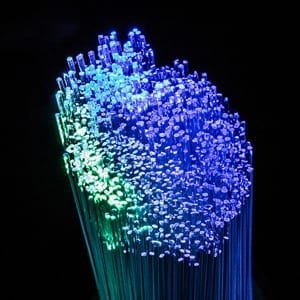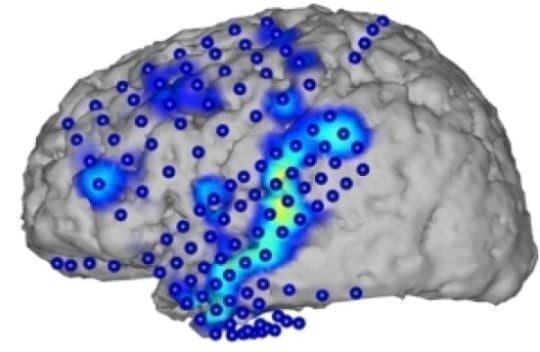
Researchers have announced an advance that could double the capacity of fiber-optic circuits, potentially opening the way for networks to carry more data over long distances while significantly reducing their cost.
Writing in the journal Science on Thursday, electrical engineers at the University of California, San Diego proposed a way to extend the range that beams of laser light in fiber-optic glass wires can travel and, in theory, achieve that dramatic improvement.
One way to understand the challenge of sending data through fiber-optic circuits is to imagine a person shouting to someone else down a long corridor. As the listener moves farther away, the words become fainter and more difficult to discern as they echo off the walls.
A similar challenge confronts the designers of networks that carry data. Beams of laser light packed densely in fiber-optic glass wires need to be both amplified and recreated at regular intervals to send them thousands of miles. The process of converting the optical ones from light to electricity and then back again roughly every 60 miles is a significant part of the cost of these networks. The process also limits how much data they can carry.
In its report, the group described a way to “predistort” the data that is transmitted via laser beams so that it can be deciphered easily over great distances.
This is done by creating, in effect, guardrails for the light beams with a device known as a frequency comb — using very precise and evenly spaced signals — to encode the information before it is transmitted.
That has the effect of embedding a digital watermark in the original data, making it possible to transmit data accurately over much longer distances and dispense with the need to perform optical-to-electronic conversions at relatively short intervals.
The researchers said they had set a transmission record for a fiber-optic message, sending it more than 7,400 miles in a laboratory experiment without having to regenerate the signal. That experiment is not discussed in the just-published paper.
The research, which has been supported in part by Google and Sumitomo Electric Industries, a maker of fiber-optic cables, is a step closer to the vision of an “all-optical network,” according to Nikola Alic, one of the authors of the paper and a research scientist in the Photonics Laboratory of the California Institute for Telecommunications and Information Technologies at the University of California, San Diego.
Such a network would be significantly less expensive and could carry more data. So far, the researchers have been able to increase the power of the lasers twentyfold to achieve transmissions over far greater distances, he said. Until now, increasing the power of the laser signal in current fiber-optic networks has been analogous to moving in quicksand — the more you increase the power, the greater the challenge of interference and distortion.
“The more you struggle, the worse off you are,” Mr. Alic said.
Bart Stuck, a venture capitalist at Signal Lake Management and a former Bell Laboratories scientist who conducted research in signal processing, said of the new paper, “This is great engineering.”
Similar ideas were used in an earlier era of communications, he noted. Although the concept was used in the world of analog voice communications, the U.C. San Diego researchers have pushed the ideas into the optical communications world.
“Their contribution is doing this at gigabits per second,” Mr. Stuck said.
Other optical scientists were more skeptical about the prospects for the new approach.
Read more: An Advance May Double the Capabilities of Fiber Optics
The Latest on: Fiber-optic circuits
[google_news title=”” keyword=”Fiber-optic circuits” num_posts=”10″ blurb_length=”0″ show_thumb=”left”]
via Google News
The Latest on: Fiber-optic circuits
- LYNN Fiber Rapid Deployment (FRD) Active & Passive Cabinetson May 9, 2024 at 9:03 am
Customizations include rack height, cabinet depth, enhanced airflow and temperature management, and factory-installed cabling and connectivity.
- Photonic Integrated Circuits (PIC) Market Surging Towards US$ 9.4 Billion by 2032, Forecast Indicates 21.5% CAGRon May 6, 2024 at 7:25 pm
The global photonic integrated circuits (PIC) market saw significant growth in 2021, reaching a total sales value of approximately US$ 1.1 Billion. The outlook for this market is even more promising, ...
- Chignik Bay latest to join GCI’s fiber optic broadband internet projecton May 6, 2024 at 6:11 pm
Chignik Bay on the Alaska Peninsula is the latest community to join GCI’s Aleutians fiber optic cable project.
- Michigan Broadband Launches Fiber-Optic Network in St. Ignaceon May 6, 2024 at 1:10 pm
Michigan Broadband has started activating new customers on the Company’s state-of-the-art fiber network that passes more than 2,000 residential and business locations throughout the City of St. Ignace ...
- Laser and Fiber Optic Gas Absorption Spectroscopyon May 6, 2024 at 11:43 am
32, Issue. 10, p. 104209. Zobair, Md Abu Esmaeelpour, Mina Gannot, Israel and Roodenko, Katy 2024. Designing a ppb-level fiber-optic microphone for photoacoustic spectroscopy of trace gases. p. 19. An ...
- Actelis Receives Order and Delivers Instant, Secure Fiber-Grade Networking to Modernize City of Bakersfield, Californiaon May 6, 2024 at 1:48 am
Crosstown specializes in the installation of Electrical and ITS Infrastructure, fiber optics, copper, wireless, communications, and closed-circuit television systems. Over the past 20 years, they have ...
- Fastwyre Broadband Begins Its Initial Investment in Central Alabama Bringing Its Fiber Optic Network to the Regionon April 25, 2024 at 7:31 am
Fastwyre is investing in upgrades to its network and service reliability, delivering unparalleled connectivity across its footprint and within this region. Fastwyre has a deep-rooted history in ...
- Fiber internet providers 2024 | Fastest plans availableon April 22, 2024 at 1:20 pm
Fiber internet is a high-speed internet connection that uses fiber optic lines. Fiber optic lines are made of very thin pieces of glass or plastic, each thinner than a human hair, that are bound ...
- DSL vs. Cable vs. Fiber Internet: Major Differences, Pros And Conson April 18, 2024 at 6:39 am
Figuring out which high-speed internet plan to sign up for can be surprisingly daunting when you’re faced with three different types of internet connection: DSL, cable and fiber optic.
- IQ Fiber's new fiber-optic internet service in Gainesville to go live later this monthon April 12, 2024 at 9:04 am
A Jacksonville-based internet company that announced in September plans to bring its fiber-optic network to Gainesville is finally ready to flip the switch on its $50 million investment IQ Fiber ...
via Bing News










